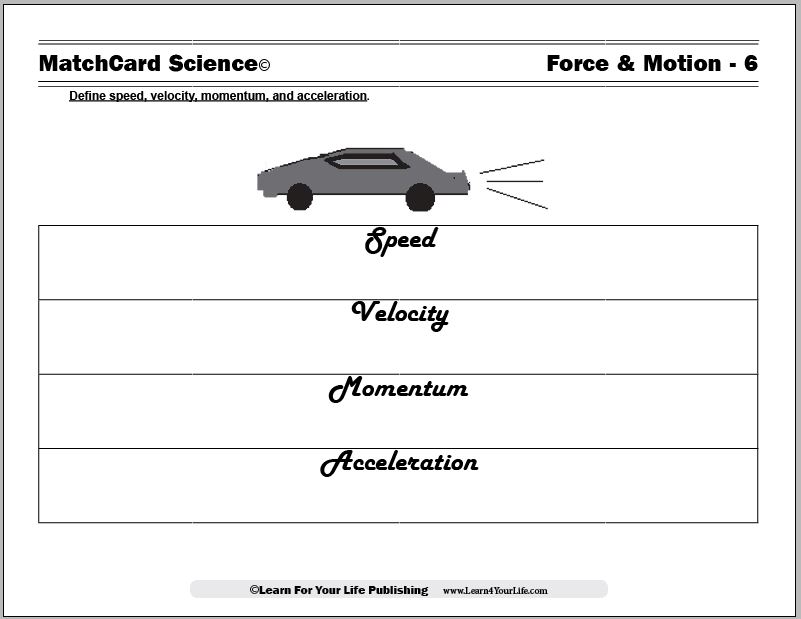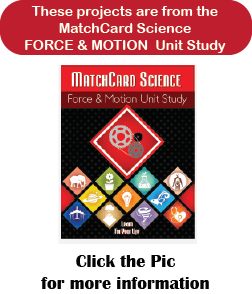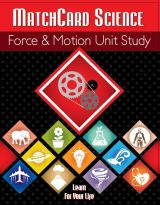Speed Velocity Momentum Acceleration
This Force and Motion MatchCard compares speed, velocity, momentum, and acceleration.
Free Download Below


Speed Velocity Momentum Acceleration MatchCard
Objective: Define speed, velocity, momentum, and acceleration.Provides the definition, formula, examples and demonstration activities for speed, velocity, momentum, and acceleration.
Projects: Toy car for demonstrations. Describe an amusement park ride you would invent using these terms.
Download and Use the Speed Velocity Momentum Acceleration MatchCard


This is MatchCard #6 of the Force and Motion Unit Study. You can find more information on MatchCard Science below.
Getting Ready: Optional Hands On Activities
Let's Get On Track for Studying Motion
Here are two alternatives for performing hands on demonstrations with speed and motion. You will want to use at least one. Suggested materials are listed, but you may have other brands that suffice.Blu Track Tracks
These are like the Hot Wheel Tracks but more flexible. If you have a Hot Wheels or any other track that reachs at least four feet, you can use it instead.Check Amazon and Walmart for best prices on Blu Track. They are not easy to find locally. You do not need to order the larger sets with ramps unless you desire to, as you can create your own ramps with a heavy object like books or laundry detergent.
Make a Marble Track
Make your own track for marbles with two meter sticks (or four or six sticks for a longer track.) Lay them side by side so there is a groove in the middle large enough to be a track for a marble. Use a piece of thick construction tape or thin piece of wood at the each end to tape them together.Timer
You will also want a timer. If you don’t have one, you can download a timer app on your phone (not quite as accurate.)Speed
Session One
Speed is the amount of distance in a given time.Use a toy car to visualize the concept of speed. If you went 25 miles in one hour, what is your speed? What if you went 150 miles in 2 hours?
When we travel, we often use miles per hour, though much of the world uses kilometers per hour.
In physics, speed is often measured in meters per second.
Let's Measure Speed
Use the track to either measure the rate of the cars or the rate of the marble in meters per second. For added fun, increase the height at the start of the track. This applies the principles of inclined plane and gravity that were learned earlier.Let’s Run
What is your speed when you run? Have someone time you as you run the 50 yard (47 meter) dash. How many seconds did it take you?Formula For Speed
Rate equals distance divided by time:Rate = Distance/Time
OR
R = d/t
OR
R = d/t
Examples of Different Speeds
What objects might travel the following speeds:- 50 mph
- 1,000,000,000 miles per second
- 10 meters per second
- Knots
Learning About Knots and Speed
Have you ever heard of knots? It is the speed used by sailors. Think of how hard it would have been in historical eras to calculate your speed on water with nothing but water around you on all sides.Knots & Nautical Mile
To calculate their speed, sailors would tie knots in a rope every 50 feet. One end of the rope was tied to a heavy weight and thrown overboard. Then using an hour glass, they would count how many knots of the rope went over the ship in 30 seconds. That would tell them how many nautical miles per hour the ship was sailing.How Much Is A Nautical Mile
A nautical mile is a little longer than a regular mile.1 nautical mile = 1.15 miles
Unless you are planning on becoming a sailor or navigator, you don’t need to memorize this converstion.
How Much is a Knot
A knot is a speed. 10 knots is equal to the rate of 10 nautical miles in one hour. It is incorrect to say 10 knots per hour. The hour is already included in the knots by definition.Velocity
Session Two
We are going to compare speed and velocity. We'll start with an unexpected activity.Run for Velocity
Today we are going to measure your speed and velocity. Put on your running shoes and head outside. While someone is timing you, run down your driveway. Then turn and run back. What was your speed? What was your velocity?Of course, you know that you can find your speed by measuring distance divided by time.
Without evening knowing you I can tell you what your velocity was.
It was 0.
What is Velocity?
Do you now know what velocity is and how it compares to speed?Definition of Velocity
Velocity is speed in a specific direction.Example of Velocity
Use your toy car to visualize this example.Imagine you were traveling to another city at 50 miles per hour. You traveled for one hour. Then you realized you forgot something. The car is turned around, and you go 50 mph for 30 minutes. Your speed was 50 mph. However, you only traveled 25 miles in one and a half hours. That is a velocity of 16 mph. Not much progress for someone going 50 mph, is it?
Velocity and You
So why was your velocity zero after running as fast as you could down the driveway and back? Answer: There was no progress in any direction.Velocity in the Skies
Velocity is often used with airplane travel. In addition to changing directions, air planes also travel up and down. The velocity, however, is speed in a given direction from the beginning to the end of the trip. Velocity is written as speed in a given direction, and usually the direction is stated.Examples:
- North at 45 mph
- Southeast at 350 mph
Measure Velocity with Toy Cars
If you have the BluTrack make some fun loops and bends. Time the cars with the new design. Describe how your final measurement is a velocity and not a speed. Answer: You are timing the length it took the car to go from the beginning of the track to the end in straight meters. You do not measure the distance traveled up and down as the car made the loops.Momentum
Session Three
Now that we have learned about speed and velocity, its time to focus on momentum.Let’s Think About It
What would do more damage? A large truck going 25 mph that hits a building, or a small car that hits the same building? Why?Momentum is the scientific concept that multiples mass with speed. This next activity will demonstrate that.
Big Car, Little Car
If you are using the track, let a lighter and heavier car go down the track and hit you in the hand. Keep your eyes closed. Can you tell which one was heavier?Big Marble, Little Marble
If you are using the marble track, use a big marble and light marble and let them hit you. As an alternative, you can set up a small object at the end that the marbles will hit and move. See which marble moves the object the furthest.What Is Momentum?
Momentum is defined as the power of a moving object to keep moving. In our first example of the truck and the car, the heavier truck had more power to keep moving because it had more weight. Therefore, it can do more damage.Momentum Formula
Here’s the formula for momentum:Mass X Velocity
You learned about mass in MatchCard #2. Remember that ounces and pounds are used for weight, and grams and kilograms are used for mass.
Measure Momentum
Let’s put it all together now. You will need to get these three measurments:- Mass of vehicle or marble
- Length of straight track (no loops or bends)
- Second timer
- Small scale to measure the mass of your vehicle or object. A postal scale can be used and convert from ounces to grams (Remember one ounce is 28 grams.)
Word Study: Momentum & Snowball Effect
In our common language we often talk about “momentum” and “the snow ball effect.” This might be a good time to review what the snow ball effect is. The snow ball picks up mass (gets larger) and velocity (speed going downhill) with time. Therefore, it gains momentum.Popular ideas and trends often are said to “gain momentum” even if there is no scientific object. Can you discuss examples?
Momentum of a Truck
You measured the momentum of the marble or car. Let’s think about the momentum of a semi-truck. They can weigh 7000 kilograms unloaded. If an unloaded semi was speeding down the highway at 50 miles per hour, how much momentum does it have? (Answer: 350,000 kg/mile/hour.)I think it’s a pretty good idea to get out of the road!
Acceleration
Did you know there is an accelerator in every vehicle? What is it for? It makes the vehicle go faster.Definition of Acceleration
The definition of acceleration is the change in speed over time.Example of Acceleration: Wind Up Car
Let’s use a wind up toy car, as an example:- It starts at 0.
- It is at 10 cm at the end of 1 second.
- It is at 20 cm at the end of 2 seconds.
- It is at 30 cm at the end of 3 seconds.
- It is at 40 cm at the end of 4 seconds.
- Change in speed: 0.4 meters per second
- Amount of time: 4 seconds
- Acceleration: 0.1 meters per second per second
Seconds Squared
Instead of second per second, we call that seconds squared. So it would be writen as: 0.1 m/s2Graph It
Use to graph paper to graph of the speed of the wind-up toy in the example we just did. The time is recorded on the x axis going across the bottom. The distance traveled is recorded on the y axis going up and down the paper.It is standard when graphing time to record it on the x axis.
Another Example: Real Cars
We identify the speed in real vehicles in miles per hour. Of course, if we are measuring the acceleration, we don’t time the car once per hour as we would a marble or toy car. The speed would be measured every second, and that measurement would be mathmatically converted to mph.1 mile per hour = 0.45 meters per second
- Let’s say you are riding in a car at 25 miles per hour. The road merges into a larger highway with a 45 mile per hour speed limit. Your car accelerates from 25 miles per hour to 45 miles per hour over 5 seconds.
- Change in speed: 20 mph or 0.9 mps
- Amount of time: 5 seconds
- Acceleration: 0.18 m/s2
Back to the Tracks
Let’s use the marble or vehicle tracks again to demonstrate acceleration. Make an incline and watch the objects get faster as they move down the incline. This acceleration will give them the momentum to keep going when the track becomes level.Experiment with what happens as you make the incline steeper. Keep in mind that an inclined plane is one of our six simple machines. Of course, the wheel and axel are also used if you are using the cars.
Why does the steeper incline make the vehichle or marble accelerate? Answer: Gravity
Acceleration and Gravity
A free falling object in our atmosphere will accelerate at a rate of 9.8 meters per second squared. That means every second it will fall 9.8 meters per second faster than it did the second before. So if you were to drop a penny out of an airplane, it would be accelerating pretty fast. It the plane was one kilometer (1000 meters) up in the sky, its speed would be 9800 meters per second an impact. Since a penny weighs about 2.5 grams, what would the momentum be.- Hints: One kilometer is 1000 meters
- One kilogram is 1000 grams
- Momentum is mass x velocity
Deceleration
The opposite of acceleration is deceleration. The speed of the object is decreasing. The formula for it is the same: change of speed over time. However, it will be a negative number.In fact, scientists generally refer to acceleration as positive (going faster) and negative (deceleration.)
The Accelerator In Your Car
Every vehicle has an accelerator to accelerate the vehicle. What is used to declerate? Answer: the brakes.0 to 60
Meters per second is the units used to measure acceleration. However, when people are shopping for a new car, they are often interested in how fast the car can accelerate (particularly race car drivers and their teams.) Of course, drivers are much more used to thinking about miles per hour, rather than meters per second.So car enthusiasts have a different method of discussing acceleration than scientists do. They measure how fast a car can go from stationary to sixty miles per hour. The average car can do it about 8 seconds - though it is not recommended. Its rough on the cars’ engine, which is why the race car drivers have a team of mechanics to work on their cars. Something your parents don’t want to pay for first time you drive down the driveway.
- Scientists identify acceleration: meters per second squared
- Consumers identify acceleration: 0 to 60
- Race car drivers accelerate: 0 to 60
- Regular drivers: don’t go 0 to 60 unless they have money for a new vehicle.
Meters Per Second Squared
This same concept can be written:- Meters per second per second
- Meters per second squared
- m/s2
- m/s/s
One More Thought On Motion & Physics
Contribution of Isaac Newton
For thousands of years mathematicians did not know how to measure motion. They had an idea of speed of course, but did not have the ability to quantify changes in speed. It was Issac Newton that developed the graph with time on the x axis and distance on the y axis that allowed motion to be scientifically charted and compared. Thus physics began. Today we are so used to seeing graphs with the measurement of time we take it for granted. But science and technology did not advance until Newton came up with that graph.
Project: Amusement Park Rides
How do speed, velocity, momentum and acceleration apply to amusement park rides? Describe a new amusement ride you would like to invent, and use these terms in your description.
MatchCard Science
How To Use MatchCards

Download the FREE MatchCard Science Instructor's Guide and see how MatchCards can make building their science knowledge base fun.
Force & Motion Unit Study

It will take four to six weeks to complete the seven objectives in this Unit Study.
Download the entire Force And Motion Unit Study.
12 Science Unit Studies

Chemistry is only one of twelve complete unit studies for kids in 3rd to 8th grade.
Comprehensive objectives, hands-on projects, suggested science fair experiments, and the fun game-like MatchCards keep them interested in learning science. See all twelve MatchCard Science Unit Studies.
About Our Site
Hands-On Learning













